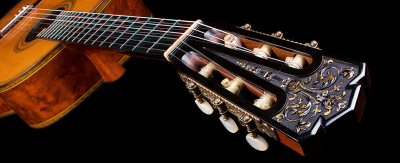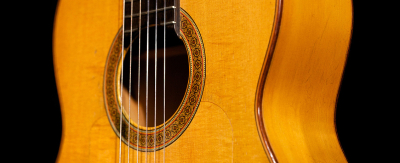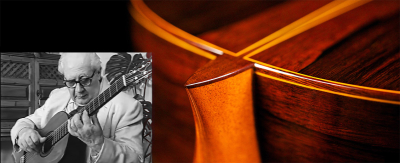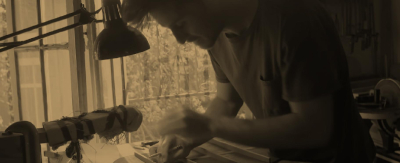Andrea Tacchi Interviews Daniel Friederich
In Paris, in the heart of Faubourg St. Antoine (the district traditionally populated by wood workers and highly skilled cabinet-makers), passing through a courtyard one finds the atelier of luthier Daniel Friederich. The large workshop, composed of a few rooms, is full of wood, a realm of silence. The high windows, which don’t face the street, have curtains situated in such a way that the even light diffuses following the rules with which the maestro has organized the whole studio. Everything appears arranged so as to minimize any possible distractions: the position of the workbenches, lighting, and above all, the optimal location of tools. No unnecessary loss of energy, especially mental.
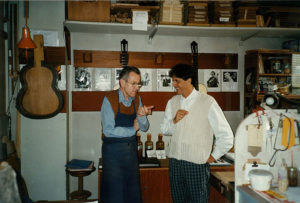 AT: Maestro, wood is the history of your family…
AT: Maestro, wood is the history of your family…
DF: I am the fourth generation of a family that has always worked with wood. My great grandfather, a furniture maker, arrived in Paris from Luxembourg in 1857 and established himself in this ‘arrondissement’ (district of Paris). At the beginning, times were hard for him and earning a living was tough. After him, my grandfather with his four brothers, and then my father, all continued as cabinet-makers. This quarter, Faubourg Saint Antoine, was the biggest European center for the construction of luxury furniture for a rich clientele needing to furnish their embassies, villas and castles. Even the imperial-style furnishings in the Oval Office at the White House were constructed here. In the 17th century, up until the mid-19th century with Napoleon III, there was a big boom in Paris, construction everywhere and consequently much work for the cabinet-makers.
AT: And you, Maestro, what was your training and how did begin your approach to this work? What is your story?
DF: I was born in 1932, and after my basic school studies I enrolled at the “école publique d’ébénisterie Charles Baudelaire” in Paris, and graduated in 1949. In 1948 I had acquired my first guitar – a steel string. In 1954 I went to a classical guitar concert at the École Normale. I was so fascinated with the performance that during the intermission I went to ask the organizer where I could learn to play in this style. I was so excited that instead of writing the actual address he provided (“Rue Descartes”), I wrote “Rue de la Guitare”. It was none other than Ida Presti who was playing that evening. Her confidence, mastery and elegance, her command of dynamics and tonal contrasts made this a powerful experience. She had a very clear idea as to which elements made the guitar such an interesting instrument – she was the “Queen” of the guitar and has yet to be equaled… I then became a student of Maestro Christian Aubin. The instrument I had was not of the best quality and a Bouchet or a Spanish guitar were far out of my reach, so Maestro Aubin, who knew about the technical and practical aspects of guitar construction, encouraged me and helped me to build one – a copy of a Simplicio. This was in 1955 and marked the beginning of the process which led me in 1959 to change my vocation from cabinet-maker to “guitar maker”.
AT: How did you proceed after that?
DF: Upon the completion of my 15th guitar I went to Maestro Robert Bouchet, who courteously received me and gave me technical advice of a practical nature. Afterwards, I had contact with Ida Presti and Alexandre Lagoya, who offered great encouragement and who also introduced me to Professor Emile Leipp, director of the Laboratory of Musical Acoustics, where I did some coursework. In 1967 I participated with success in the Liege Luthier Competition (in the jury were Antonio Monzino, Ignacio Fleta, president, and Robert Bouchet). In the beginning I made two models of my own design: one less expensive and simpler to build: the “Recital”, not numbered; and the other, called “Concert”, which was more refined and well-finished. Both models were made with rosewood and spruce. Since 1970 I have built only the Concert model. Seeing as experiment is necessary and everything else is just “academic”, in 1971 I slightly changed the form of my instrument. The design decisions I make follow only one rule – that they please me aesthetically. That same year, starting with guitar number 279, I started to experiment with the of use double sides. Basically I glue two layers of 2mm thick wood together to get a side of 4mm total. I was immediately aware that this gave a more modern character to the instrument – the sound of the fingernail attack changed and there was less “drum” sound coming from the body. I also started to use Western Red Cedar as soundboard material, which I used for the first time for Turibio Santos in 1974 (guitar number 378), and after 1975 it became a constant for many years. This magnificent material, lightweight and flexible, gives a warm sound, and immediately creates a sound which to me is “très guitare”. I subsequently made adjustments to the bracing system with the intention of modifying the attack as well as other aspects of the sound. In 1975 I started using an asymmetrical fan bracing system and in 1980 I added a transverse bar between the sound hole and the bridge with the dual purpose of helping the soundboard sustain the rotational torque of the bridge and limit the basses. I have found that too much exaggerated bass has a negative influence on the polyphonic clarity – the trebles are always covered, veiled. To achieve an attack that had more “bite” to it, I started (in 1981) adding two transverse bars below the sound hole. With this technique, the primary frequency of the soundboard went up to 110Hz, or the note La/A. This, which is my second type of fan bracing, is well suited for guitarists with a softer attack, in fact it adds brilliance and speed to the sound. Since the beginning of my career up to the present my guitar has gradually increased in weight from about 1550 grams up to 1750-1850 grams. Other modifications came in the following years, by small, progressive adjustments. I found it necessary to modify one thing at a time because changing everything in one instrument is a real gamble. I could only do that if I had to build a replica of one made many years ago, but in this… I’m not interested. My path has been like that of a painter who can’t paint the same picture twice his whole life. Now I’m on my 747th guitar.
AT: You, besides being a protagonist, have witnessed forty years of classical guitar history. Can you talk a bit about it from the luthier’s point of view?
DF: At the time I started, many players performed on traditional Spanish guitars such as Manuel Ramirez, Vicente Arias, Antonio de Torres, Francisco Simplicio. That was the type of instrument that interested most people, mainly because they are easy to play. Then, step by step, different styles of guitars emerged and evolved in different directions. The Fleta family for example, professionals since 1929 – drastically changed the design of their standard instrument in 1955. Still with much inspiration from the past, they made an instrument with a slender neck and a thin soundboard that had a sound with a very deep sonority that literally “hit you in the stomach”. Later they greatly increased the thickness of the soundboard around the bridge and in general the weight of the instrument. José Ramírez III, whose guitars were used by Andrés Segovia, was able to develop a modern instrument of his design. Hermann Hauser II also contributed developments to the evolutionary puzzle with the insertion of the under-bridge bar which was technically a good solution for distributing string tension more evenly across the top and avoiding soundboard deformation. In parallel, Bouchet very early on, moved away from Torres, increased the weight of the instrument and above all, melded the traditional Spanish system with a transverse bar under the bridge already present in some preceding French instruments, first in those of Lacote and later in those of Grobert. It’s no surprise that Bouchet possessed a beautiful Lacote that can now be found in the Paris Museum of musical instruments. Bouchet was also probably one of the first (along with Enrique Garcia) to create asymmetry in the thicknesses of the fan braces, making the struts lower on the bass side and much thicker and stronger on the treble side. This construction gave more homogeneity to the sound, longer sustain of the notes and greater balance between basses and trebles. Playability improved in that the guitar had a more responsive attack – with either a softer, easier touch or a good and strong touch. This combination of “adjustments” produced a guitar that was clearly superior to the other guitars of the same period. As a kind of “proof” of this there are many beautiful recordings done with Bouchet guitars. I was in contact with him for 26 years, I have an entire book of letters and cards he wrote to me. He was a good painter and teacher at the academy… This painting he gave me was painted by him.
AT: Observing your work from the aesthetic and structural points of view, one could say that you impose an iron discipline. In your opinion, are auditory research and aesthetics of equal value?
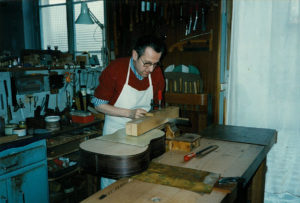 DF: While the notion of “beautiful” always changes, that of “well-made” does not. It remains for centuries. I aim to respect this second notion. At times I make slight modifications to the inlays. For example the colors of the purflings, the rosette and others. Even though my guitar is already difficult to make and takes me 250 hours of work, “and even more at my age” (this note added in 2013) I am always curious to pursue more knowledge by prudent experiment, and also in personalizing an instrument for a given musician. A general rule is that whatever the instrument, in the end I have to like it. Generally though, guitarists are only interested in the sound, which at times is… frustrating.
DF: While the notion of “beautiful” always changes, that of “well-made” does not. It remains for centuries. I aim to respect this second notion. At times I make slight modifications to the inlays. For example the colors of the purflings, the rosette and others. Even though my guitar is already difficult to make and takes me 250 hours of work, “and even more at my age” (this note added in 2013) I am always curious to pursue more knowledge by prudent experiment, and also in personalizing an instrument for a given musician. A general rule is that whatever the instrument, in the end I have to like it. Generally though, guitarists are only interested in the sound, which at times is… frustrating.
AT: On this front, Maestro, do you personalize the sound of your guitars according to the guitarist who has commissioned an instrument?
DF: I build for a wide variety of classical guitar playing styles and for guitarists who represent an international panorama of very different approaches to the instrument. It’s important therefore to make guitars which are suitable to these different ways of playing, thus making the most of the combination between instrument and musician. Some players have a light and “silvery” sound, others have a dark sound and play deep into the strings. The shape of the finger and the nail makes the quantity of sound and sustain an extremely personal matter. Regarding power and duration, it is necessary to note that volume isn’t just absolute momentary intensity – over time, the sound must decay slowly after its peak. A guitar that decays too quickly is not an interesting guitar to me. In any case, returning to the initial question, I have a very detailed archive of every single instrument I’ve built, where the quality, weight and flexibility of every principal part of the guitar is noted, along with thicknesses and dimensions of the soundboard, the back, the neck and the braces. That way if there is a request for a guitar similar to another that I made previously, I can execute a precise “replica”.
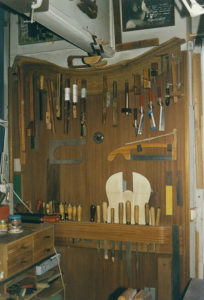 AT: Maestro, I can’t help but ask you to comment on the technical questions regarding wood, dimensions and how these interact.
AT: Maestro, I can’t help but ask you to comment on the technical questions regarding wood, dimensions and how these interact.
DF: After years of building cedar-top instruments, I have now for the last three years (Mr. Friederich was referring to 1994, as the original interview was made around 1997) gone back to making guitars also in spruce, progressively and carefully, being careful to avoid going back thirty years in time, preserving, that is, the “modern” character of my current work, while re-visiting this wood of my earlier guitars. You can change everything – the bars below the soundhole, the thickness of the neck and heel, the back bars. These will affect certain aspects of the sound, such as sustain, beauty and strength. The playability of an instrument is also an important element of the construction process. Between cedar and spruce, I find that guitars built with cedar are more flexible and lighter, they’re deeper and easier to play. When using spruce, I find that drastically diminishing the thickness of the soundboard around the bridge and the dimensions of the internal structure, the sound can begin to approach that of cedar. Vice versa, I have some cedar with a specific gravity of 400kg/mc, similar to a lightweight piece of spruce, which I don’t use willingly – the sound produced is a bit too “light”, I’ve got to reflect on this some more… Anyway you can’t change anything in the guitar without having an effect on the sound.
AT: What do you think of the rumor that the life-span of cedar guitars is much shorter than spruce?
DF: I would say more generally that there are soundboard woods that age faster than others, even of the same species. I believe it depends on how the cells of the each piece of wood are naturally joined together. There are guitars of mine in cedar that have been played a lot and still sound “new”. For instruments which may lack a certain vigor, in part you can compensate using carbon strings which generally have higher tension.
AT: And regarding the neck and back?
DF: The neck is of notable importance. I use both Spanish cedar (Cedrella odorata) and Honduran mahogany (Swietenia macrophylla) for the neck, I like them both. It is always necessary to weigh the wood because even from the same plank two necks can have a mass that differs as much as 100 grams. If then, by misfortune a heavier-than-usual fingerboard (for example 50 grams more) is used, you’ll get a neck/fingerboard combination which completely throws off the physical balance of the instrument. For this very reason I quickly stopped using heavy Cuban mahogany. As for the back, if it is also heavy, the instrument will surely be unpleasant and difficult to play, and less sensitive overall. I find that guitars which weigh more than 1900 grams present problems. The lighter the guitar and generally less resistant the structure, the easier it is to play. Yet I also consider the weight an important factor which brings about the nuances in timbre, power and sustain. In the end, regarding the body, I don’t see the absolute need to use CSA rosewood. Some luthiers attribute superior qualities to it, with the only real aim being to raise the price of the instrument! I, instead, generally prefer woods that are a little lighter. Lately however I’ve started becoming more of a believer again in the marriage between spruce and CSA rosewood. With a thick back and thin, flexible top I’m able to obtain some interesting results. In any case there is one rule that applies to the many aspects of guitar construction: there is no “black and white”, only many shades in between.
AT: And what are your preferences regarding the sound?
DF: Generally I don’t like guitars with a sound that is too clear and tight, but rather those with a full-bodied sound. I also don’t like dry or metallic trebles nor thin basses. I prefer the sound of the piano to the Harpsichord if that is a useful comparison.
AT: Maestro, you are one of the few builders who has had the occasion to frequent and work seriously in a big acoustic laboratory, side-by-side with technicians and authorities in the field such as Professor Emile Leipp. In your opinion, with all the knowledge of acoustics and physics which is currently available, what sense could it have, if any, to design an instrument on a computer?
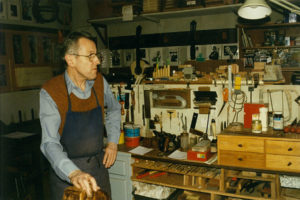 DF: In reality I’m not a “scientific luthier”, but it has been an enormous pleasure for me to know of the research done by experts in these fields, starting with the simple and ending with the complex. I began by reading with great interest the works by the major authorities of the last century in the field of acoustics: Savart, Chladni, Helmholtz, Bouasse and in the end Leipp, with whom I conducted elaborate experiments on the guitar. The reduction of art to mathematics is an ancient dream of mankind, a seductive utopia: cellos whose form is dictated by musical proportions, architecture conceived on the basis of 1.618, or the golden mean, or the proportions of the human body. After Descartes it has regularly been imagined that we can resolve anything by means of calculations and mathematics. With a computer you can make music, play chess, and if you give it enough information we could without a doubt design an ideal guitar in some sense. But in the end, every instrument needs to be heard, to be judged by the ear, an organ without equal in this field, capable of analyzing and appreciating extremely complex sounds in fractions of a second. Thus, I believe that intuition and experience still have a good future and great possibilities. While old-fashioned artistry still solidly dominates the field of guitar making, marvelous electronic instruments can help shed light on the remaining dark spots in our knowledge regarding sound.
DF: In reality I’m not a “scientific luthier”, but it has been an enormous pleasure for me to know of the research done by experts in these fields, starting with the simple and ending with the complex. I began by reading with great interest the works by the major authorities of the last century in the field of acoustics: Savart, Chladni, Helmholtz, Bouasse and in the end Leipp, with whom I conducted elaborate experiments on the guitar. The reduction of art to mathematics is an ancient dream of mankind, a seductive utopia: cellos whose form is dictated by musical proportions, architecture conceived on the basis of 1.618, or the golden mean, or the proportions of the human body. After Descartes it has regularly been imagined that we can resolve anything by means of calculations and mathematics. With a computer you can make music, play chess, and if you give it enough information we could without a doubt design an ideal guitar in some sense. But in the end, every instrument needs to be heard, to be judged by the ear, an organ without equal in this field, capable of analyzing and appreciating extremely complex sounds in fractions of a second. Thus, I believe that intuition and experience still have a good future and great possibilities. While old-fashioned artistry still solidly dominates the field of guitar making, marvelous electronic instruments can help shed light on the remaining dark spots in our knowledge regarding sound.
AT: Getting back in part to the topic: What impression do you have of the guitars of the latest generation which make use of non-traditional materials (for example, carbon fiber or composite materials)?
DF: The impression I have is that these instruments are good “sound machines” that unleash a powerful and homogenous sound. However the design, which is modeled on the membrane of a loudspeaker, is problematic regarding the aesthetic quality of the sound it produces. First of all, the sound of the nail at the attack is heard clearly even before the note, amplified by the “membrane of the soundboard” especially at the edges where it is very thin. Secondly and more importantly is the lack of “filtering” of the sound, which is the result of the choices made by the luthier during the process of thicknessing and bracing of the soundboard. To elaborate: These new instruments generally have bodies which are very rigid, heavy, neutral and reflective. In contrast to this, the soundboards are very thin, sometimes reinforced with light (but rigid) materials like balsa (a very lightweight wood) and carbon fiber. These types of soundboard systems typically amplify everything that the string transmits – all of the harmonics produced by the string are thus present in the sonic spectrum, limiting the role of the builder to producing an “anonymous” timbre. Important variations and nuances in sound, color and dynamics (which are the very character of a particular instrument and its luthier) are therefore lost. It’s a sound that’s too much the same. Devoid of variety, it’s simply not interesting, the poetry is lacking and the listener becomes bored. To summarize, guitars which I call “Drum-guitars” – each note comes out with a very strong, explosive attack but is in the end displeasing and graceless. The guitarist who mostly plays with rest stroke should not use one of these guitars. Guitarists who don’t have great power in their hands could use these, as could those who prefer to play with well-defined and precise free strokes.
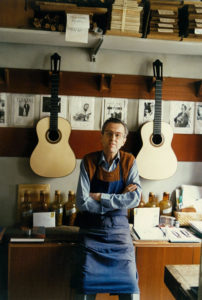 AT: Could you give some advice to anyone who has the wish to buy a luthier-built instrument?
AT: Could you give some advice to anyone who has the wish to buy a luthier-built instrument?
DF: I find this question so special, so personal that I can’t help but respond: “Buy a Tacchi or a Friederich!” (laughing)
AT: In your opinion, what are the qualities a luthier should have, and what talents should be cultivated?
DF: More than anything, I’d say that one shouldn’t undertake this profession without a true calling, it’s necessary to have a natural predisposition toward this complex work. Beyond this, one needs a good dose of patience, courage and the ability to control one’s own insecurities. I advise young luthiers to educate their ear and especially to acquire a memory of sound because it is much harder to judge the sound of an instrument than the sound of the human voice. I advise further to play the guitar, and to be knowledgeable about current research and understanding in the field of musical acoustics. There is a lot to learn, nonetheless even if the path of each luthier can be considerably different, one rule goes for all: you’ve got to love the guitar.
AT: The Italian actor Marcello Mastroianni, speaking about the profession of the actor, has said: “Ours is a fantastic profession, they pay us to continue performing”. On the occasions in which I frequented Maestro Bouchet, this was the impression I had of his vision of guitar making. His advanced age notwithstanding, he had a lively curiosity about the next guitar to build, he showed a youthful enthusiasm towards his craft. What do you think about this?
DF: Concerning Mastroianni’s affirmation, I’d say in general we get paid a lot less! Robert Bouchet was an exceptional person: he loved the guitar, youth, funny stories, friends, traveling, life. In summers he didn’t work, he passed the season in his little house in the countryside 80 km outside of Paris. I’m very different from him – restless, a kind of “luthier-monk”. And having always worked professionally, I’ve conducted a very different life, regimented by precise deadlines. It’s also tiring, difficult work. It has been however a great pleasure to progress in this profession and be constantly researching new technical and artistic solutions, something which I have always had a passion for. I have also had the honor to know and listen to musicians of great merit and artistry.
And so concludes the “interview” with Maestro Daniel Friederich, which was compiled from many encounters and discussions over a twelve-year period. My impression is that every response he provided was pondered attentively through a continuous observation of his work and its results, brought along by a deep technical awareness. I think that this should become the working rule in the development of a concrete future for lutherie. I take this occasion to publically thank Maestro Friederich for the important responses he gave to us.
-Andrea Tacchi
Originally published 1998 in Il Fronimo (Translation 2013 by John Weissenrieder)
Andrea Tacchi would also like to thank: Mrs. Lena Kokkaliari, editor of “Il Fronimo”, who courteously allowed the use of the interview originally published in the aforementioned magazine long ago (1998 volume Nr. 101), Luthier John Weissenrieder, who scrupulously oversaw the translation from Italian, guitarist Gabriele Natilla, who for years has been living in Paris and teaching at the Conservatoire d’Argenteuil who helped with this final draft, collecting directly from Mr. Friederich the last corrections, updates and photos. And finally Mr. Tacchi would like to give his heartfelt thanks to Maestro Friederich.
3 comments

